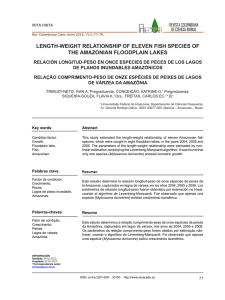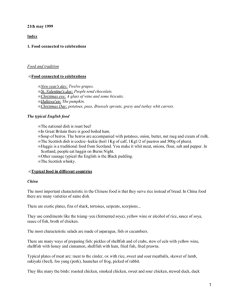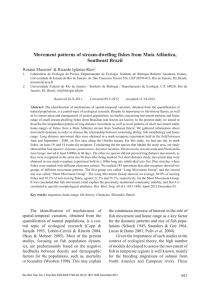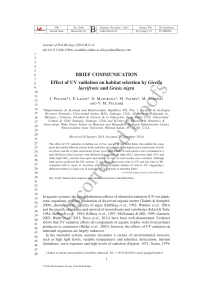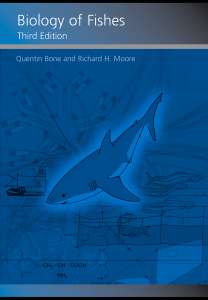diet composition of fish assemblage of lake tupe, amazonas
Anuncio
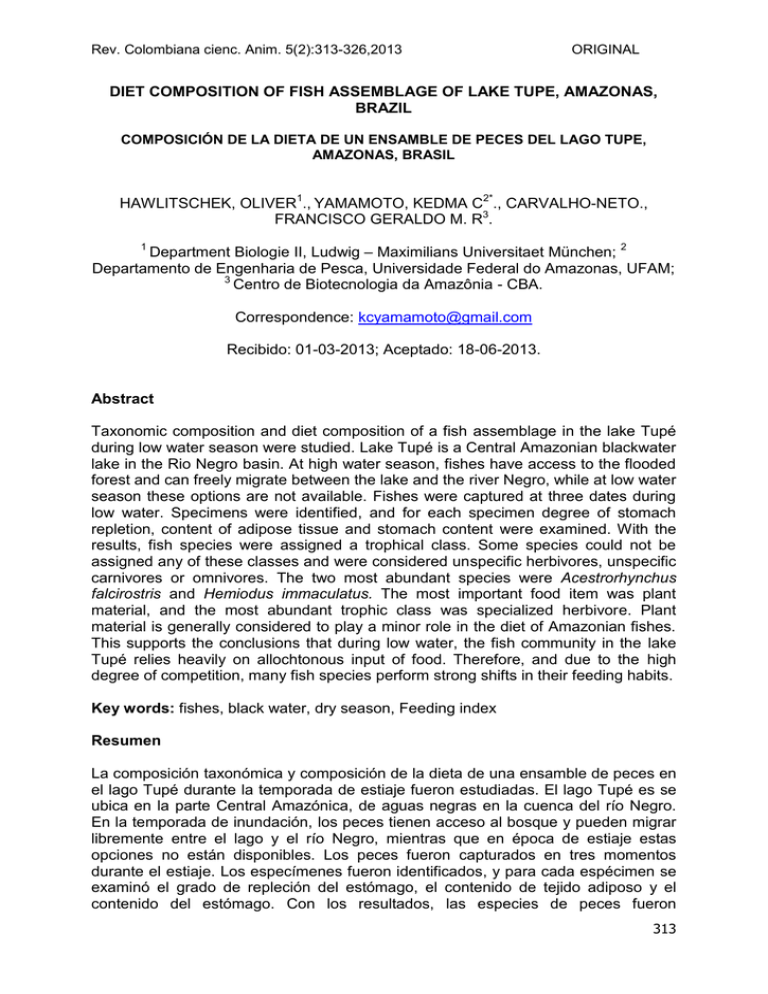
Rev. Colombiana cienc. Anim. 5(2):313-326,2013 ORIGINAL DIET COMPOSITION OF FISH ASSEMBLAGE OF LAKE TUPE, AMAZONAS, BRAZIL COMPOSICIÓN DE LA DIETA DE UN ENSAMBLE DE PECES DEL LAGO TUPE, AMAZONAS, BRASIL HAWLITSCHEK, OLIVER1., YAMAMOTO, KEDMA C2*., CARVALHO-NETO., FRANCISCO GERALDO M. R3. 1 Department Biologie II, Ludwig – Maximilians Universitaet München; 2 Departamento de Engenharia de Pesca, Universidade Federal do Amazonas, UFAM; 3 Centro de Biotecnologia da Amazônia - CBA. Correspondence: [email protected] Recibido: 01-03-2013; Aceptado: 18-06-2013. Abstract Taxonomic composition and diet composition of a fish assemblage in the lake Tupé during low water season were studied. Lake Tupé is a Central Amazonian blackwater lake in the Rio Negro basin. At high water season, fishes have access to the flooded forest and can freely migrate between the lake and the river Negro, while at low water season these options are not available. Fishes were captured at three dates during low water. Specimens were identified, and for each specimen degree of stomach repletion, content of adipose tissue and stomach content were examined. With the results, fish species were assigned a trophical class. Some species could not be assigned any of these classes and were considered unspecific herbivores, unspecific carnivores or omnivores. The two most abundant species were Acestrorhynchus falcirostris and Hemiodus immaculatus. The most important food item was plant material, and the most abundant trophic class was specialized herbivore. Plant material is generally considered to play a minor role in the diet of Amazonian fishes. This supports the conclusions that during low water, the fish community in the lake Tupé relies heavily on allochtonous input of food. Therefore, and due to the high degree of competition, many fish species perform strong shifts in their feeding habits. Key words: fishes, black water, dry season, Feeding index Resumen La composición taxonómica y composición de la dieta de una ensamble de peces en el lago Tupé durante la temporada de estiaje fueron estudiadas. El lago Tupé es se ubica en la parte Central Amazónica, de aguas negras en la cuenca del río Negro. En la temporada de inundación, los peces tienen acceso al bosque y pueden migrar libremente entre el lago y el río Negro, mientras que en época de estiaje estas opciones no están disponibles. Los peces fueron capturados en tres momentos durante el estiaje. Los especímenes fueron identificados, y para cada espécimen se examinó el grado de repleción del estómago, el contenido de tejido adiposo y el contenido del estómago. Con los resultados, las especies de peces fueron 313 Rev. Colombiana cienc. Anim. 5(2):313-326,2013 ORIGINAL asignados a una clase trófica. Algunas especies no se pudieron asignar en cualquiera de estas clases y fueron considerados herbívoros inespecíficos, carnívoros u omnívoros inespecíficos. Las dos especies más abundantes fueron Acestrorhynchus falcirostris y Hemiodus immaculatus. El tipo de alimento más importante fue material vegetal y la clase trófica más abundante fue herbívoro especializado. El material vegetal generalmente se considera que desempeñan un papel de menor importancia en la dieta de los peces amazónicos. Esto apoya la conclusión de que durante el estiaje, la comunidad de peces en el lago Tupé basa en gran medida su dieta en la entrada alóctona de los alimentos. Por lo tanto, y debido al alto grado de competencia, muchas especies de peces realizan fuertes cambios en sus hábitos de alimentación. Palabras clave: peces, agua negro, la estación seca, la alimentación indice Introduction Organism communities in Central Amazonian river basins are strongly influenced by the annual flood cycles (Junk et al., 1989). Many organisms are adapted to water level fluctuations of up to 10 meters. At high water, the inundated forests offers a highly structured habitat and rich food supply for animals, which is not accessible at low water (GOULDING et al., 1988). Additionally, the aquatic habitat is divided during the period of high water. Lakes and smaller water bodies are connected to the river at high water, but are separated at low water. This is especially important for large and highly mobile animals like fishes. Some fish species perform annual migrations between rivers, lakes and inundated areas, while others remain faithful to their habitats (RODRIGUEZ et al., 1990; SAINT-PAUL et al. 2000; SILVANO et al., 2000). Many species also change their nutritional preferences during the hydrological cycle (MERONA and RANKIN-DE-MERONA, 2004). Although numerous studies have already dealt with fish communities and trophic structures in the Amazon (GOULDING et al. 1988; WINEMILLER and JEPSEN, 1998; SILVANO et al., 2000; MERONA and RANKIN-DE-MERONA, 2004), there is still a lack of understanding these complex ecologic relationships. Deeper knowledge of this topic is important, however, as fish play an important ecological role due to their large biomass and high mobility. Fish are also of great importance for Amazonian human populations as an important protein source. Also in the present study area of the RDS Tupé (sustainable development reserve), nearly the whole population covers part of its food requirements by fishing (TERRA et al., 2005). Black water areas, such as the river Negro and the lake Tupé, host far smaller fish stocks than white water areas, such as the river Solimões (SAINT-PAUL et al., 2000). Therefore, a sustainable management of this natural resource is particularly difficult there. Consequently, comprehensive studies on the community ecology and the trophic relations of fish assemblages are especially important in black water areas. 314 Rev. Colombiana cienc. Anim. 5(2):313-326,2013 ORIGINAL In this paper we study the fish assemblage of the lake Tupé as a study of a seasonally isolated black water fish assemblage. We present data on the taxonomic composition of this community and of the diet of all the species comprised. Then, we compare our results to those of previous studies on Amazonian fish communities and attempt to detect the specific features that characterize the diet of a fish assemblage that is isolated in a lake during low water. Material and methods Study area: The lake Tupé is a black water lake situated at 60° 15' 17.5" West and 03° 02' 35.4" South. This position is at the left bank of the Rio Negro, upriver from the confluence of Rio Negro and river Solimões and about 25 kilometers from Manaus (Fig. 1). The mean annual water level fluctuation is 10 meters. At high water, lake and river are broadly connected, while at low water they are connected only via a shallow channel. This forms a barrier against the migration of most animals during the low water season from September to November. The lake is surrounded by black water inundation forests (igapós), which at high water are flooded and accessible for lake organisms, and by mainland rainforest, which is never flooded (SANTOS et al., 2005). Figura 1. Location of Reservation Tupé sustainable development and the lake. Image extracted from http://biotupe.inpa.gov.br. Sampling: The sampling was performed at three dates from mid of October to beginning of November 2006. Fishes were captured by gill nets with mesh sizes from 30 to 90 millimeters. The total deposition time of nets in the water was 24 hours for each sampling date. Fishes were collected from the nets every six hours at 24:00 and 06:00 hours (night-time catch) and 18:00 and 12:00 hours (day-time catch), fish were 315 Rev. Colombiana cienc. Anim. 5(2):313-326,2013 ORIGINAL collected under license n0 16889-1/IBAMA. Captured specimens were fixed in 10% formaldehyde The taxonomic identification of specimens and all further analyses were performed at the laboratories at CEULM/ ULBRA (Centro Universitário Luterano de Manaus) and INPA (Instituto Nacional de Pesquisas da Amazônia) in Manaus both. The relative abundance of each species was computed based on the taxonomic data. Stomach content analysis: From every specimen, the degree of stomach repletion, the content of adipose tissue, and the stomach content were examined in the laboratory under a stereomicroscope. The degree of stomach repletion was classified as 0 (empty), 0 to 25%, 25 to 50%, 50 to 75%, and 75 to 100% (YABE E BENNEMANN, 1994). The content of adipose tissue was classified as degrees 1 (no or almost no adipose tissue present), 2 (some adipose tissue present), and 3 (very much adipose tissue present). In the analysis of stomach content, eight classes of food were discriminated: algae, plant material (vegetative parts of vascular plants), detritus, fruits / seeds, zooplankton, fish, insects (terrestrial and aquatic), shrimp. Any material that was in a too advanced state of digestion to be assigned to any of these classes was considered digested material. The proportional composition of the stomach contents of each specimen was estimated. Analysis: The proportional volume of each food item in each stomach in which it was present, and the relative occurrence of each food item per number of specimens per species were used to compute the IAi (KAWAKAMI E VAZZOLER, 1980) with the following formula: IAi Fii Vi n ( Fi V ) i 1 IAi = Feeding index Vi = Proportion of a food item in the stomach content of a specimen Fi = Frequency of occurrence of the food item i = Food item The resulting numbers of feeding index (IAi) were transformed into percentage values. With this data, every species was assigned to one of the following trophic guilds: algae eater, specialized herbivore, detritivore, frugivore, zooplanktivore, piscivore, insectivore and, shrimp eater. Species were considered specialists of one of these classes if the IAi of one food item made up for at least 60% of the total. If this was not the case, but if the total IAi of plant or animal food items made up for at least 60% of the total, a species was considered unspecialized herbivore or unspecialized carnivore. If none of these conditions matched, a species was considered omnivore. Any stomach content could not be established of four species (Boulengerella lucius, 316 Rev. Colombiana cienc. Anim. 5(2):313-326,2013 ORIGINAL Boulengerella lateristriga, Sorubim lima, Satanoperca lilith); these species were excluded from the classification. Using the program PAST (HAMMER et. al., 2001), a principal component analysis (PCA) of the nutritional data of each specimen was performed. This statistical method allows two-dimensional visualization of multivariate data by modelling variation among the original variables as vectors (i.e. principal components). Results Taxonomic composition: 317 specimens of 33 species, 14 families, and three orders were captured. The most abundant species were: Acestrorhynchus falcirostris (Characidae) and Hemiodus immaculatus (Hemiodontidae) with each N= 45 specimens and relative abundance of 14.20%, followed by Auchenipterichthys thoracatus (Auchenitperidae, N= 32, relative abundance 10.09%), Acaronia nassa (Cichlidae, N= 30, relative abundance 9.46%) and Semaprochilodus insignis (Prochilodontidae) N=23, relative abundance 7.26%) (Fig. 2). Figure 2. Relative abundance of the 12 most abundant fish species in the Lago Tupé, Amazonas, Brazil. The most abundant families were Cichlidae (N = 72), Hemiodontidae (N = 70), Acestrorhynchidae (N = 45), Curimatidae (N = 25) and Prochilodontidae (N = 24). The most abundant order was Characiformes (N = 189), followed by Perciformes (N = 75) and Siluriformes (N = 53) (Table 1). 317 Rev. Colombiana cienc. Anim. 5(2):313-326,2013 ORIGINAL Table 1. List of fish species captured in the Lago Tupé, Amazonas, Brazil with number (N), degree of stomach repletion (GR) and results the Feeding index (IAi) stomach analyses. FOOD ITEM ORDER, FAMILY, GENUS AND SPECIES Characiformes Characidae Acestrorhynchus falcirostris (Cuvier, 1819) Agoniates anchovia Eigenmann, 1914 Metynnis hypsauchen (Müller & Troschel, 1844) Ctenoluciidae Boulengerella lucius (Cuvier, 1816) Boulengerella lateristriga (Boulenger, 1895) Anostomidae Laemolyta varia (Garman, 1890) Curimatidae Curimata vittata (Kner, 1858) Cyphocharax abramoides (Kner, 1858) Erythrinidae Hoplias malabaricus (Bloch, 1794) Hemiodontidae Hemiodus gracilis Günther, 1864 Hemiodus immaculatus (Kner, 1858) Hemiodus unimaculatus (Bloch, 1794) Hemiodus cf, argenteus Pellegrin, 1909 Hemiodus sp, Micromischodus sugillatus Roberts, 1971 Prochilodontidae Semaprochilodus insignis (Jardine & Schomburgk, 1841) Semaprochilodus taeniurus (Valenciennes, 1817) Siluriformes Auchenipteridae Auchenipterichthys thoracatus (Kner, 1858) TROPHIC GUILD ALGAE PLANT MATERIAL FRUIT SEEDS N GR piscivore piscivore 45 1 11.1 25 0 0 0 12.5 0 12.5 0 0 0.1 0 0 0 99.9 75 0 0 omnivore 1 75 0 22.2 77.8 0 0 0 0 0 piscivore piscivore 1 2 0 0 0 0 0 0 0 0 0 0 0 0 0 0 0 0 0 0 herbivore 11 25 0.8 51.6 0 47.6 0 0 0 0 detritivore detritivore 12 13 33.3 59.6 0 0 78.6 82.9 0.2 0 21.2 17.1 0 0 0 0 0 0 0 0 piscivore 9 13.9 0 0 0 0 0 0 100 0 herbivore herbivore herbivore herbivore herbivore herbivore 1 45 1 2 3 18 75 28.5 25 12.5 41.7 46.7 44.4 6.4 0 0 11.1 3.1 33.3 80.3 100 100 66.7 64.3 0 0 0 0 0 0 22.2 3.4 0 0 0 24.6 0 9.6 0 0 0 7.9 0 0 0 0 22.2 0 0 0 0 0 0 0 0 0 0 0 0 0 detritivore 23 7.6 0 72.3 1.4 25.5 0 0 0.7 0 detritivore 1 25 0 100 0 0 0 0 0 0 insetivore 32 45.3 0 0.5 0 0 99.5 0 0.1 0 DETRITUS INSECTS ZOOPLANKTON FISH SHRIMP 318 Rev. Colombiana cienc. Anim. 5(2):313-326,2013 Doradiade Astrodoras sp, Loricariidae Loricariichthys acutus (Valenciennes, 1840) Pseudoloricaria laeviuscula (Valenciennes, 1840) Pimelodidae Pimelodus blochii (Schomburgki, 1841) Sorubim lima (Bloch & Schneider, 1801) Perciformes Cichlidae Acarichthys heckelii (Müller & Troschel, 1849) Acaronia nassa Cichla monoculus (Spix, 1831) Cichla temensis Humboldt, 1821 Geophagus cf, altifrons Heckel, 1840 Geophagus sp, Mesonauta festivus (Heckel, 1840) Satanoperca acuticeps (Heckel, 1840) Satanoperca lilith Kullander & Ferreira, 1988 Sciaenidae Pachypops trifilis (Müller & Troschel, 1849) ORIGINAL detritivore 3 33.3 0 0 0 91.1 7.1 1.8 0 0 detritivore 15 26.7 1.7 11.4 0 86.9 0 0 0 0 detritivore 1 50 0 50 0 50 0 0 0 0 carnivorous piscivore 1 1 25 0 0 0 37.5 0 50 0 0 0 12.5 0 0 0 0 0 0 0 herbivore herbivore piscivore piscivore frugivore herbivore herbivore planktivore planktivore 8 30 1 11 1 5 2 13 1 25 25.8 25 25 50 15 37.5 36.5 0 6.5 9.4 0 0 0 18.8 53.3 0 0 42.6 65.1 0 2.1 0 18.8 0 8.1 0 0 0.9 0 0 100 0 0 0 0 42.6 0 0 0 0 31.3 46.7 21.9 0 3.2 21.3 0 4.8 0 12.5 0 1.2 0 1.6 0 0 0 0 18.8 0 68.8 0 3 2.1 0 93.1 0 0 0 0 0 0 1.3 0 0 0 0 0 0 0 piscivore 3 33.3 0 0 0 0 20 0 80 0 319 Rev. Colombiana cienc. Anim. 5(2):313-326,2013 ORIGINAL Diet composition: The most important food item was plant material (IAi = 49.17%), followed by insects (IAi = 21.90%), detritus (IAi = 15.26%) and fish (IAi = 9.83%). The sum of the remaining food items algae, fruits / seeds, zooplankton and shrimp was less than 4% of the total (Fig. 3). Figure 3. Occurrence of food items (IAi) in the nutrition of Lago Tupé fishes, Amazonas, Brazil. Within the major food items, plant material, detritus, algae, fruits / seeds and shrimp could not be determined to a lower taxonomic level. Insects included aquatic insects (larvae of dipterans and ephemeropterans, aquatic hemipterans) as well as terrestrial insects (coleopterans, isopterans, hemipterans). Among the terrestrial insects, winged ant queens were by far the most important food source in the last of the three catches. Fish consisted of various species of characiform and perciform fishes. Zooplankton (IAi = 0,96%) was composed mainly of cladocerans and ostracods. The most important trophic guild, in numbers of species as well as abundance, was specialized herbivores with 10 species and together 118 specimens. Unspecialized herbivores was second most important in numbers of species (6 species, 24 specimens), but piscivores was second most important in abundance (5 species, 69 specimens) (Fig. 4, Table 1). The results of the analyses of stomach repletion and adipose tissue are shown in Fig. 5. 320 Rev. Colombiana cienc. Anim. 5(2):313-326,2013 ORIGINAL Figure 4. Trophic guilds representation of specimens and species of Lago Tupé, Amazonas, Brazil.Relative abundance per food class (%), shown for specimens (dark grey) and species (light grey). Food classes: SpHe = specialized herbivore, Pisc = piscivore, Inse = insectivore, UnHe = unspecialized herbivore, Detr = detritivore, Plct = planktivore, Omni = omnivore, Frug = frugivore Thus, the most abundant fish species can be assigned to the following trophic guilds: Acestrorhynchus falcirostris (Acestrorhynchidae): Piscivore, Hemiodus immaculatus (Hemiodontidae): Specialized Herbivore, Auchenipterichthys thoracatus (Auchenipteridae): Insectivore, Acaronia nassa (Cichlidae): Specialized Herbivore, Semaprochilodus insignis (Prochilodontidae): Specialized Detritivore. Figure 5. Degree of stomach repletion and adipose tissue in the 12 most common fish species of Lago Tupé, Amazonas, Brazil. Stomach repletion (dark grey) and content of adipose tissue (light grey) are shown. Adipose tissue was transformed to percentage for better visualization In the principal component analysis, axis 1 with an eigenvalue of 654.918 is responsible for 30.049% of the total variation, followed by axis 2 with an eigenvalue of 571.373 (29.795% of total variation). This means that axes 1 and 2 alone are 321 Rev. Colombiana cienc. Anim. 5(2):313-326,2013 ORIGINAL responsible for almost 60% of the total variation within the composition of diet of the studied fishes. As shown in Fig. 6 axis 1 spans mainly between piscivores and all other trophic guilds. Axis 2 rather allows discrimination between herbivores and carnivores in general; there, insectivores and, to a lower degree, piscivores are opposed to specialized herbivores, detritivores and algae eaters. Figure.6. Plot of the principal component analysis over the trophic components in the nutrition of Lago Tupé fishes, Amazonas, Brazil. Alg = algae, Plt = plant material, Fru = fruits / seeds, Det = detritus, Ins = insects, Zoo = zooplankton, Fis = fish, Shr = shrimps Discussion Normally for the Amazon region the species belonging to the order of characiforms are dominant in lake systems. (GOULDING et al., 1988; GARCIA, 1995, SAINTPAUL et al. (2000). This matches with the results of the earlier study of SOARES and YAMAMOTO (2005). In this study, Siluriformes is the second most abundant group, while in the present study this is Perciformes. 322 Rev. Colombiana cienc. Anim. 5(2):313-326,2013 ORIGINAL The most abundant species form shoals. SOARES and YAMAMOTO (2005) found Acestrorhynchus falcirostris as the most abundant species during low water season with relative abundance of more than 40%. In the present study, its relative abundance is 14.2%. ood sources most used by the population studied was plant material (vegetative parts of vascular plants). In contrast to our results, this food item normally is of minor importance for Amazonian fishes (GOULDING et al., 1988; MERONA and RANKINDE-MERONA, 2004; WINEMILLER and JEPSEN, 1998, YAMAMOTO et al., 2004) and has never been found to be the prime nutritional source of fish communities. A reason for its importance here may be the scarceness of other food items for herbivores and omnivores during low water in black water areas. During this period, black water is especially poor in nutrients (GOULDING et al., 1988). This reduces the availability of normally important food items for herbivores and omnivores like algae and zooplankton. Various food sources that are available during high water cannot be used at low water. Among these are algae growing on the barks of inundated trees in the igapó forests, tree fruits and seeds and terrestrial insects falling from the forest canopy (GOULDING et al., 1988). Fish species that feed on these items while they are available need to switch to other resources at low water. Our results show that even some species that are otherwise considered piscivores, like Acaronia nassa (MERONA and RANKIN-DE-MERONA, 2004), switch to plant material as their main food source. This supports the high degree of trophic plasticity of Amazonian fishes demonstrated in previous studies (ABELHA et al., 2001; MERONA et al., 2001). The results of the PCA allow for an estimation of the resource partitioning in the fish assemblage during the low water season. The trophic guild which is distinguished best is piscivores, as hardly any piscivore species take any other food. In contrast, there are hardly any unspecialized carnivores or omnivores in whose stomachs a large quantity of fish was found. The second most conspicuous difference is found between herbivores and carnivores, showing that true omnivores are very rare. As stated above, trophic plasticity is common among Amazonian fishes (ABELHA et al., 2001; MERONA et al., 2001); our results, however, conform to studies (MERONA and RANKIN-DE-MERONA, 2004; TEDESCO et al., 2007) showing that, despite this plasticity, Amazonian fishes within a certain fish assemblage tend to show a high degree of nutritional specialization, leading to efficient resource partitioning. At decreasing water levels, fishes often have the possibility to emigrate (SAINTPAUL et al., 2000). Many species, however, remain in the lake also at low water and do not leave before the water levels begin to rise. Some herbivore species like Micromischodus sugilatus, Curimata vittata, and Laemolyta varia show a high degree of adipose tissue, but continue to feed, as proven by undigested material found in 323 Rev. Colombiana cienc. Anim. 5(2):313-326,2013 ORIGINAL their stomachs (Fig. 5). These potamodromous species use their reserves for their reproductive migration upstream at rising water. Other migratory fishes like Semaprochilodus insignis also leave the lake at rising water (SAINT-PAUL et al., 2000), but seem not to feed during the low water season. In contrast to herbivores, piscivores like Acestrorhynchus falcirostris, Cichla temensis, and Hoplias malabaricus can take advantage of the low water season. They experience a net increase of prey abundance due to the reduction of the water body and a concentration of the same number of prey fishes in a smaller water volume. Additionally, prey fishes do not have the possibility to seek cover in the highly structured inundated forests. Despite the higher prey abundance, less specialized carnivore and omnivore species do not appear to feed on fish more frequently. Instead, like Acaronia nassa, they switch to other food items, even plant material. This may be caused by the extremely high abundance of the shoaling open water predator Acestrorhynchus falcirostris, being the most abundant species together with the herbivore Hemiodus immaculatus, with a relative abundance of 14.2%. In the previous study by SOARES and YAMAMOTO (2005), A. falcirostris had a relative abundance of 44.2% during low water, while no other species had a relative abundance higher than 8.3%. This study also showed that A. falcirostris remained in the lake only during low water period, emigrating afterwards. Together with these results, our results suggest that its large numbers make A. falcirostris so strong a competitor that many, but not all other piscivores present in the lake are forced to shift their feeding habits to different food items. Insects form the third most important food category. During high water levels, terrestrial insects falling from trees in the inundated forests normally form an important food source (MERONA and RANKIN-DE-MERONA, 2004). However, these are not available at low water. Insectivore fishes have to rely on aquatic insects and on terrestrial insects imported from other sources, like the surrounding mainland forests. Among the insects taken up as food in the lake Tupé, winged ant queens dominate. The ants seem to swarm from nests in the neighbourhood of the lake in large numbers. Thus, crashing ant queens provide a frequently, though not continually availably food source to the fishes of lake Tupé, which is used by various species. Hemiodus immaculatus is normally known as an insectivore fish (MERONA and RANKIN-DE-MERONA, 2004). We found in our study that this species relied on ant queens to supplement its plant diet. The most important ant consumer, however, is Auchenipterichthys thoracatus. Nearly all captured specimens of this species had stomachs full of ants, only a few stomachs also included fish or plant material. Most specimens also had a high degree of adipose tissue, possibly due to use of this resource. The species seems very efficient in the opportunistic use of this food item, and is therefore a strong competitor for primarily insectivore species like H. immaculatus. GOULDING et al, (1988) mention this species as frugivore and important in the ichthyochorous spreading of seeds. However, in our study we did not find any fruits or seeds in any specimen of A. thoracatus. As most seeds are 324 Rev. Colombiana cienc. Anim. 5(2):313-326,2013 ORIGINAL available only at high water, when the forests are flooded, their importance for the fish community at low water is low. Specialized fruit and seed eating fishes immigrate in large numbers only after the flooding of the forests, being erratic in the low water period. One of these erratic specimens was the single captured individual of Metynnis hypsauchen. Nevertheless, its stomach was filled with seeds, which shows that also scarce resources can be used by specialized species, at least if the abundance of these species is low. Conclusions During the low water season, the fish community of lake Tupé and especially the large number of herbivore species are dependent on the allochthonous input of nutrients. This input is produced in the surrounding forest, for example in the form of leaf material and terrestrial insects. Therefore, the inundation forest (igapó) is of high importance for the trophic structures in the lake also while it is not flooded. Most fish species appear to experience increased competitive pressure at low water. This may be a consequence of the reduced water volume in the lake. Another reason is that the inundation forest, which provides as food and cover in the high water period, is not accessible. Specialized piscivores take advantage from the higher abundance of prey. Many species adapt to the harder conditions by strong shifts in their feeding habits. Even species with normally carnivore habits rely to a great extent on plant material as the most easily available food item. Acknowledgements: The authors thank the German Academic Exchange Service (DAAD) for partial funding of the project and Edinaldo Nelson Dos Santos Silva for his support with the funding and project BioTupé (INPA). Further thanks go to Efrem Jorge G. Ferreira and Lucia Rapp Py-Daniel (INPA) for their assistance with the determination of fish species, and to the fishermen from São João do Tupé community for their assistance with capturing the specimens. References ABELHA, M.C.F.; AGOSTINHO, A.A.; GOULART, E. 2001. Plasticidade trófica em peixes de água doce. Maringá 23(2):425 – 434. GARCIA, M. 1995. Aspectos ecológicos dos peixes das águas abertas de um lago no Arquipélago das Anavilhanas, Rio Negro, AM. Dissertação de Mestrado, Instituto Nacional de Pesquisa da Amazônia/Fundação Universidade do Amazonas, Manaus, Amazonas, GOULDING, M.; LEAL-CARVALHO, M.; FERREIRA, E.J.G. 1988. Rio Negro: Rich Life in Poor Water. Amazonian Diversity and Food Chain Ecology as Seen through Fish Communities. SPB Academic Publishing, The Hague. 325 Rev. Colombiana cienc. Anim. 5(2):313-326,2013 ORIGINAL HAMMER, Ø.; HARPER, D.A.T.; RYAN, P.D. 2001. PAST - Palaeontological Statistics, Software Package for Education and Data Analysis. Palaeontologia Electronica 4(1):1-3. KAWAKAMI, E.; VAZZOLER, G. 1980. Métodos gráficos e estimativa de índice alimentar aplicado no estudo de alimentação de peixes. Bol. Inst. Oceanogr. 29(2): 205–207. MERONA, B.; RANKIN-DE-MERONA, J. 2004. Food resource partitioning in a fish community of the Central Amazonian Floodplain. Neotrop. Ichthyology 2(2):75-84. MERONA, B.; SANTOS, G.M.; ALMEIDA, R.GONÇALVES. 2001. Short term effects of Tucuruí Dam (Amazonia, Brazil) on the trophic organization of fish communities. Env. Biol. Fish 60(4): 375 – 392. SAINT-PAUL, U.; ZUANON, J.A.S.; VILLACORTA-CORREA, M.A.; GARCÍA, M.; FABRÉ, N.N.; BERGER, U.; WOLFGANG. W.J. 2000. Fish communities in Central Amazonian white- and blackwater floodplains. Environ. Biol. Fishes 57:235-250. SANTOS-SILVA, E.N.; APRILE, F.M.; SCUDELLER, V.V.; MELO, S. (organizadores). 2005. BioTupé: Meio físico, diversidade biológica e sociocultural do baixo Rio Negro, Amazônia Central. Editora INPA, Manaus, Brasil. SILVANO, R.A.M.; AMARAL, B.D.DO.; OYAKAWA, O.T. 2000. Spatial and temporal patterns of diversity and distribution of the Upper Juruá River fish community (Brazilian Amazon). Environ. Biol. Fishes 57: 25–35. SOARES, M.G.M.; YAMAMOTO, K.C. 2005. Diversidade e composição da íctiofauna do Lago Tupé. In: SANTOS-SILVA et al. (2005). TEDESCO, P.A.; IBAÑEZ, C.C.; MOYA, N.; BIGORNE, R.; CAMACHO, J.; GOITIA, E.; HUGUENY, B.; MALDONADO, M.; RIVERO, M.; TOMANOVÁ, S.; ZUBIETA, J.P.; OBERDORFF, T. 2007. Local-scale species–energy relationships in fish assemblages of some forested streams of the Bolivian Amazon. C. R. Biologies 330(3): 255 – 264. TERRA, A.K.; REBELO, G.H. 2005. O uso da fauna pelos moradores da comunidade São João e colônia Central. In: SANTOS-SILVA et al. 2005 WINEMILLER, K.O.; JEPSEN, D.B. 1998. Effects of seasonality and fish movement on tropical river food webs. Journal Fish Biol. 53 (A):267–296. YABE, R.S.; T. BENNEMANN. 1994. Regime alimentar de Schizodon intermedius Garavello & Britski do rio Tibagi, Paraná, e sua relação com algumas características morfológicas do trato digestivo (Osteichthyes, Anostomidae). Rev. bras. Zool. 11 (4): 777-788. YAMAMOTO, K.C.; SOARES, M.G.M.; FREITAS, C.E. C. 2004. Alimentação de Triportheus angulatus (Spix & Agassiz, 1829) no lago Camaleão, Manaus, AM, Brasil. Acta Amazonica 34(4): 653 – 659. 326
